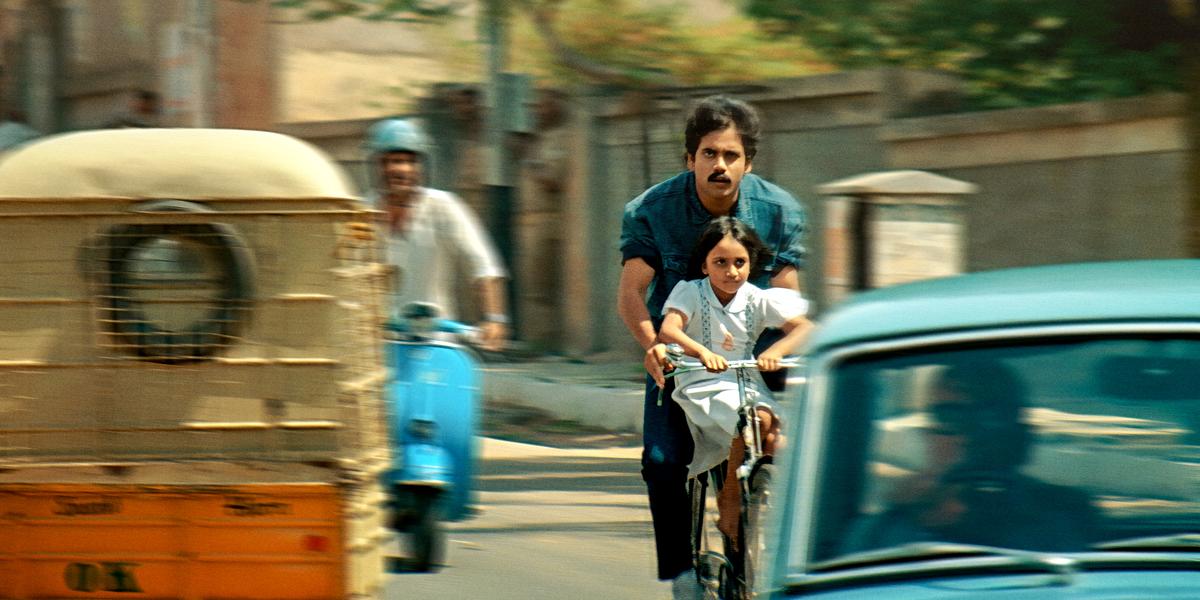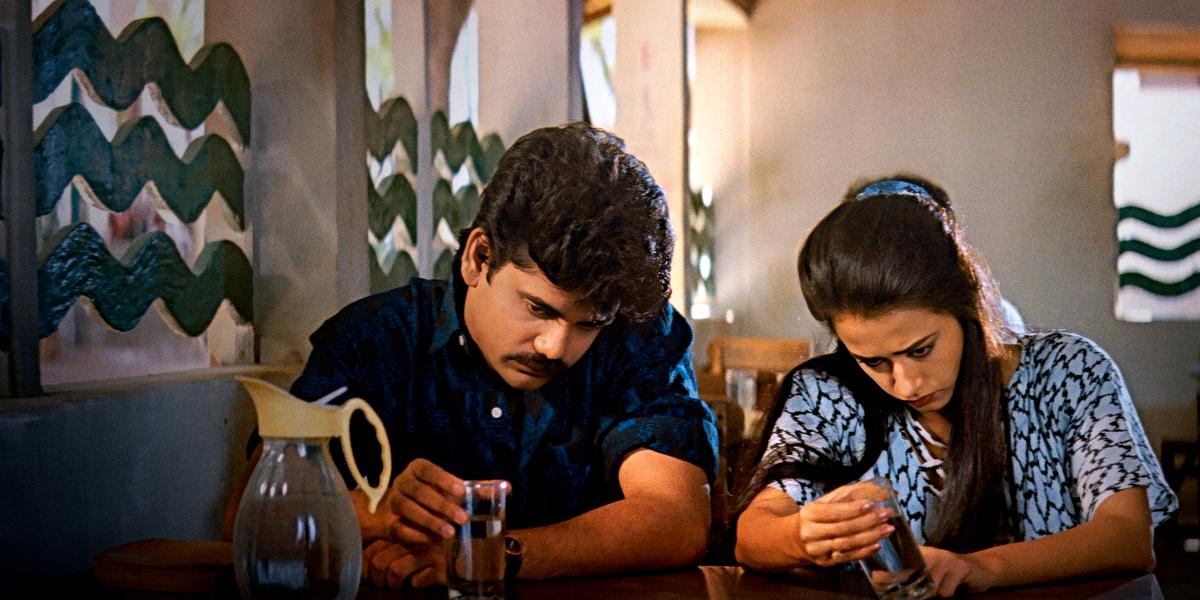“I don’t know if I will win this war, but my victory is in trying,” declares Nagarjuna Akkineni in the 1989 Telugu action film Shiva. Beyond the film’s narrative, the line captures what Nagarjuna — then a rising actor — and debut director Ram Gopal Varma (RGV) might well have felt as they created a film that swam against the tide.
Also starring Amala Akkineni, Raghuvaran and JD Chakravarthy, Shiva went on to inspire a generation of writers, directors, actors, and technicians with its innovative scene construction, sound design, cinematography, and action choreography. It redefined how student politics and gangster dramas were portrayed in Indian cinema.
The digitally restored Shiva releases in theatres on November 14. Reels of the picture negative were sourced from Prasad Labs, while the audio negatives were gathered from various prints held by exhibitors. Nearly 100 technicians worked on digitising and restoring both the video and audio.
CV Rao, Chief Technology Officer at Annapurna Studios, Hyderabad, outlines the process. The work to procure the film’s video and audio negatives, to digitising them, began years before the pandemic. “Back then, there was no plan to re-release older films produced by the studio. We simply wanted to preserve and restore some of the classics,” says Rao.
In 2019, the studio hosted a week-long film preservation and restoration workshop in collaboration with the Film Heritage Foundation of India, giving further impetus to its archival efforts.
Before the era of digital filmmaking, when movies were shot on film cameras, production houses and studios would work with post-production labs to store the negatives in large cans in air-conditioned rooms. The labs charged a maintenance fee and cleaned the negatives using ultrasonic machines once every six months or a year.
However, as labs adapted to the demands of digital cinema, attention to older film negatives began to wane.
The clean-up

CV Rao
| Photo Credit:
Special Arrangement
“The picture negative of Shiva was covered in fungus and had become sticky. The reels had to be cleaned multiple times before being scanned using a high-end Arri 4K scanner to convert it into digital footage,” says Rao. “Dust and scratches had damaged parts of the film, and some frames were even torn. About 50% of the dust and scratches were removed through mechanised cleaning, while the rest were manually restored frame by frame. Torn frames had to be painstakingly reconstructed. Around 80 to 100 people worked on restoring the footage over two months.”
Once scanned, the restored footage was still raw. Skilled technicians then worked on the colour grading, adjusting light, brightness, and contrast to match the original film’s visual tone.
Reflections on ‘Shiva’
The intersection of student and State politics in Shiva drew from RGV’s own college experiences in Vijayawada. In contrast to the loud fashion of 1980s Telugu cinema, Nagarjuna’s earthy, understated wardrobe marked a quiet rebellion.
The chase sequence with Nagarjuna and a child actor cycling and running through Hyderabad’s alleys was shot on real streets without stunt doubles. “I wonder how we pulled it off. It was a safety risk,” Nagarjuna admits.
His introduction scene, a simple walk into frame, redefined heroism. “Shiva doesn’t arrive as a hero; he becomes one when he stands up to the goons,” says RGV. “Unlike other films, his heroism is earned, not announced.”
The chemistry between Nagarjuna and Amala — who later married in real life — remains striking. “I wanted someone classy, who could hold her own amid the chaos. Amala’s quiet sophistication balanced the film perfectly,” RGV recalls.
The idea for Shiva came to RGV after watching Bruce Lee’s Return of the Dragon for the 15th time. “Venkat (Nagarjuna’s brother) asked me to write a story for him. I replaced the restaurant with a college and wrote the first draft in 20 minutes,” he says. The script was later expanded with real campus observations and gritty action in place of martial arts.
There was another major hurdle — the restoration had only been completed for the picture negative, while the sound negative, usually stored separately, was missing.
Annapurna Studios’ distribution team reached out to veteran exhibitors. “Some theatres keep old negatives as memorabilia, especially for blockbuster films, even though it requires investment — air-conditioned storage rooms and cans that can hold 30 to 40 kilograms of film,” explains Rao.

One of the memorable sequences in the film
| Photo Credit:
Special Arrangement
Sound negatives were eventually sourced from 10 exhibitors. Each can contained a mix of usable and damaged reels. After collating the good portions, the sound was cleaned and transferred to a monophonic audio track — all before the pandemic. “We weren’t satisfied with the results, so we decided to pause and reassess,” says Rao.
After the pandemic, the resurgence of re-releases fuelled by nostalgia made them revisit Shiva. But Rao, Nagarjuna, and RGV were firm that the film’s revival had to meet modern standards — pristine 4K visuals and Dolby Atmos sound.
Mono track to Dolby Atmos
Sound proved to be the biggest challenge, as the dialogues, music, and effects were all available on mono tracks. Rao and sound engineer Kannan Ganpat proposed using AI tools to recreate sound true to the original. For the experiment, they selected a 10-minute segment, including the now-iconic cycle chain fight and the chase sequence featuring Nagarjuna and his niece through Hyderabad’s bylanes.

“Ram Gopal Varma was deeply involved in the process,” Rao recalls. “We isolated the three audio components — dialogue, sound effects, and music — and refined each one. Using the original tracks as AI prompts, we incorporated plug-ins from our sound library, foley recordings, and several filters. We tested every stage, and after five weeks, screened the footage for Nagarjuna. He was blown away.”

Nagarjuna and Amala in the film
| Photo Credit:
Special Arrangement
The team then applied the same process to the entire film over four months, aiming to recreate sound compatible with Dolby Atmos while preserving its original texture. The same balance guided the visuals, ensuring the colours appealed to younger audiences while retaining the film’s original tone.
“Shiva’s darker visual palette and its raw, realistic sound were groundbreaking for their time — every punch you hear is real,” Rao notes.
The restoration demanded significant investment, though Rao declines to reveal the budget. “The studio heads were fully supportive of the experiment,” he says. “We have already received calls from other production houses interested in similar projects. Once Shiva releases and we gauge the response, we will know how viable it is to restore other classics.”
Test screenings with younger audiences, who had not seen the original, prompted a few refinements, including editing out two songs to tighten the pace. After a media preview, Nagarjuna remarked, “In the 1980s, every film needed at least five songs, regardless of genre. Even though RGV and I weren’t keen on a couple of them, we went with the trend then. Now, we’ve taken them out — but for those nostalgic about them, they’ll play after the credits.”
www.thehindu.com (Article Sourced Website)
#Nagarjuna #Akkineni #Ram #Gopal #Varmas #iconic #film #Shiva #rereleases #week #Heres #digitised #restored
